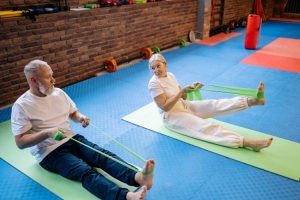Preventing Slips, Trips and Falls
Many older adults find out the hard way that having a fall can result in life altering injuries and reduced self-confidence.
In fact, having a fall is the number one reason in Canada for injury-related death, hospitalization and emergency department visits in adults aged 65 and older (1).
The good news is that there are many strategies to help you or your loved one avoid having a fall.
Practice Moving Well
Research tells us that common reasons for suffering a fall include reduced muscle strength, muscle power, reaction time, balance, and postural stability (how well you move) (2).
A physiotherapist can help to identify which of these areas you would benefit from working on the most by testing your single leg balance, walking speed, how smoothly you move, your response to stimuli, and your strength.
Here are a few items you can work on to help improve your awareness, coordination and balance.
- Strength is essential – Strong muscles are required for fast and powerful reactions. Spending at least two days each week performing lower body strength exercises can help to diminish the preferential loss of type II (fast twitch) muscle fibers that occurs as we age. Learn how to perform a squat or deadlift!
- Switch your activities / sports – New challenges are good for your brain and body. This helps to maintain quick reactions and the ability to load your tissues without incurring an injury. Have you ever tried karate?
- Proprioceptive exercises – exercises that test your balance are meant to be challenging and fun. Throw a ball to a partner!
- Low-intensity plyometrics – If you have been strength training for at least a few months consider getting some advice on hopping/jumping and reaction-based exercises from a physiotherapist or strength and conditioning coach. Can you build up your ability to hop or skip for 30 seconds?
Practice Situational Awareness
- Walk with a forward gaze. Ideally you want to look a few steps ahead of where you are so you can plan your route.
- Scan your environment – Look and listen for potential hazards including ice, dogs, people, bikes, items that could cause you to trip or slip.
- Anticipation and pattern recognition – When there are potential hazards (e.g. snow and ice on the ground), you should anticipate a potential consequence and action (you could slip – so avoid walking there, or go slowly).
- Make a decision quickly – Choose to do the “right thing” in a reasonable amount of time to avoid a potential fall.
Other Prevention Strategies
- Managing diagnoses and medications – Has there been a change to your health since you have seen your family physician last? Are you on the best medications and dosages? Check in with your family physician.
- Regular vision and hearing exams – Check in with your optometrist and audiologist every 1-2 years.
- Good quality sleep – Do you sleep 7-9 hours a night and feel rested in the morning? Discuss any concerns with your family physician.
- Reduce slipping/tripping hazards in your house and installing good lighting – An occupational therapist can help to identify concern and make recommendations.
- Wear appropriate footwear – good fitting shoes with appropriate support and tread should be worn outdoors as well as indoors for individuals at a risk of falling.
There are many things that should be considered in preventing falls.
It can be helpful to get an evaluation from the members of your healthcare team to determine which areas are the most important for you or your loved ones to work on.
References
- Yao X, Skinner R, McFaull S, Thompson W. At-a-glance – Injury hospitalizations in Canada 2018/19. Health Promot Chronic Dis Prev Can. 2020;40(9):281–7
- Gschwind YJ, Kressig RW, Lacroix A, Muehlbauer T, Pfenninger B, Granacher U. A best practice fall prevention exercise program to improve balance, strength / power, and psychosocial health in older adults: study protocol for a randomized controlled trial. BMC Geriatr. 2013;13:105
- Haff G, and Triplett NT. Essentials of Strength Training and Conditioning. Fourth edition. Champaign, IL, Human Kinetics, 2016.




